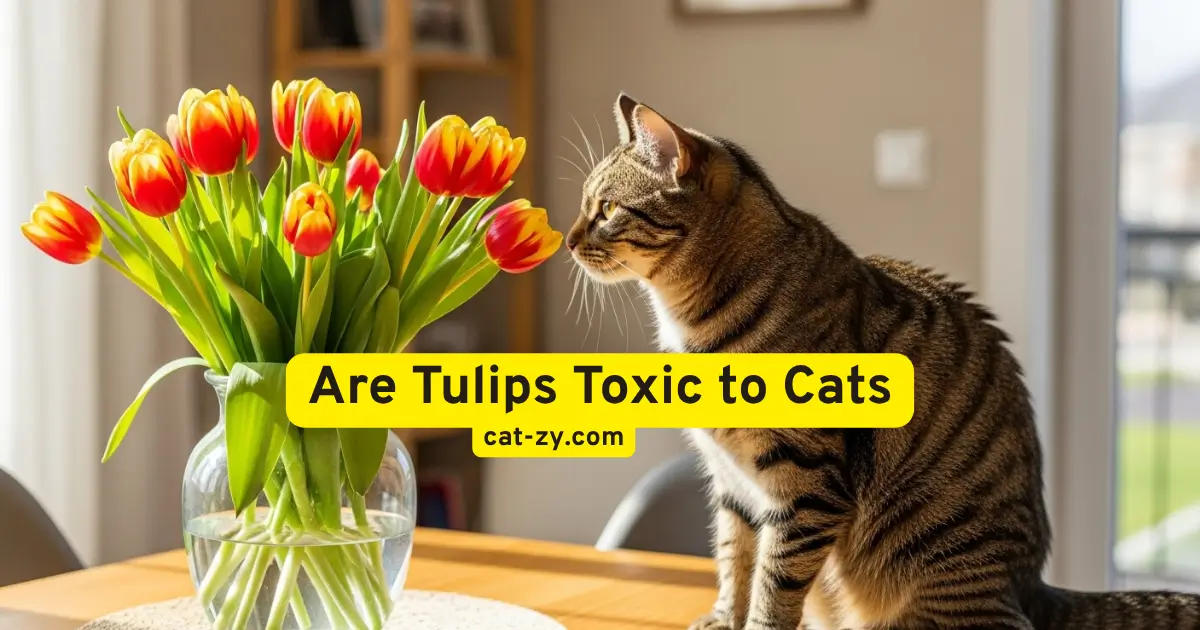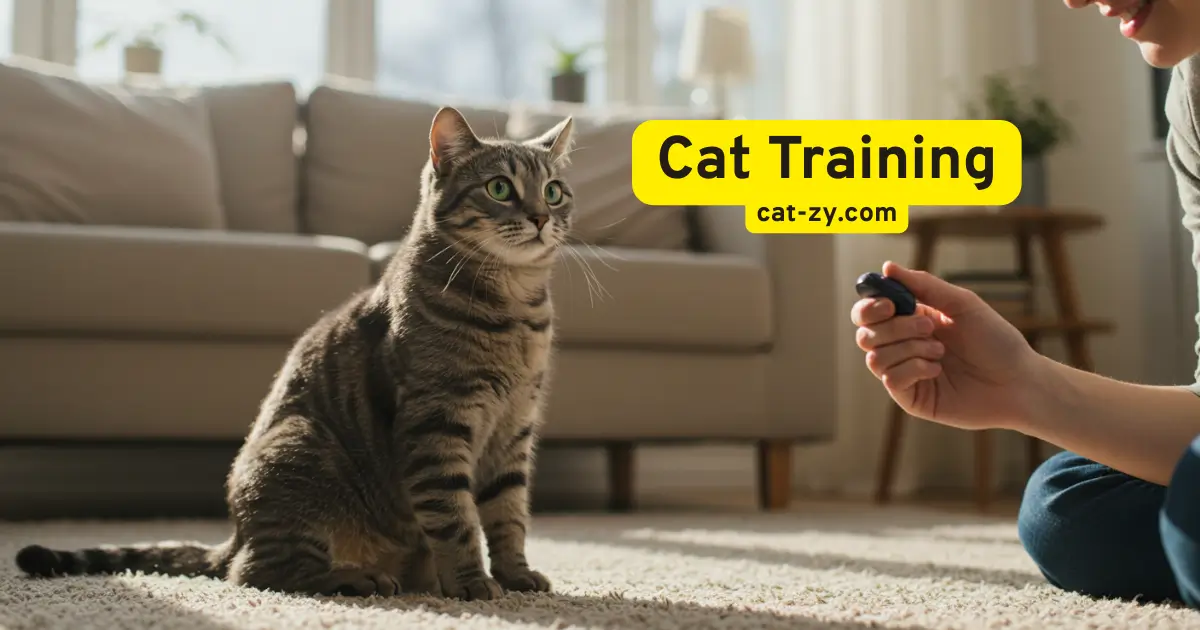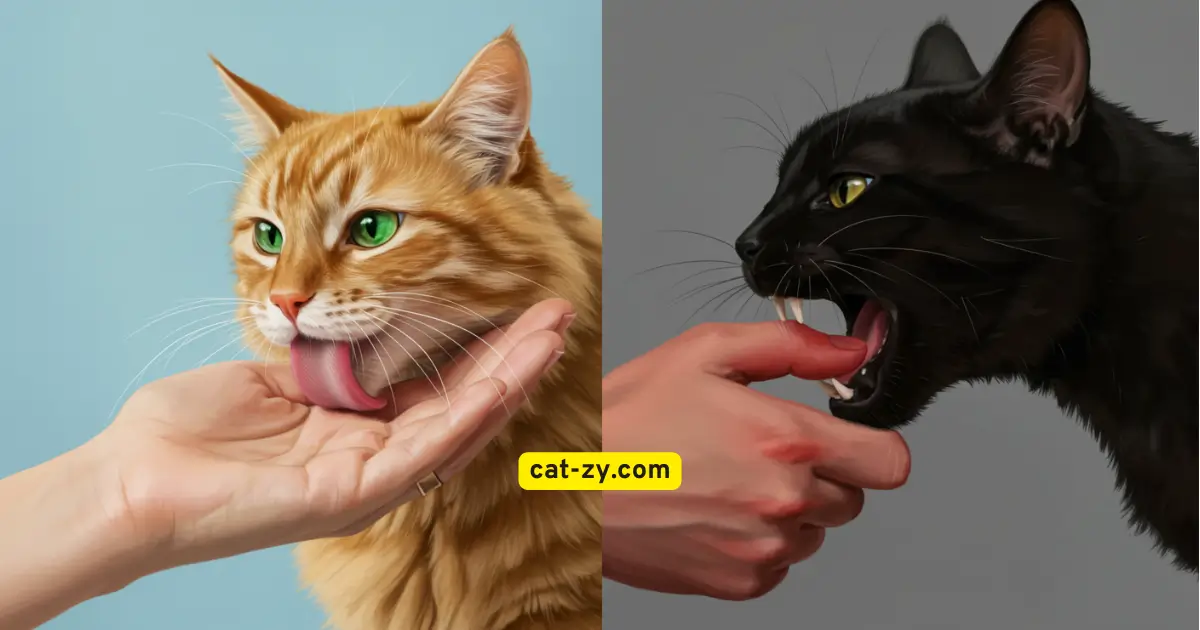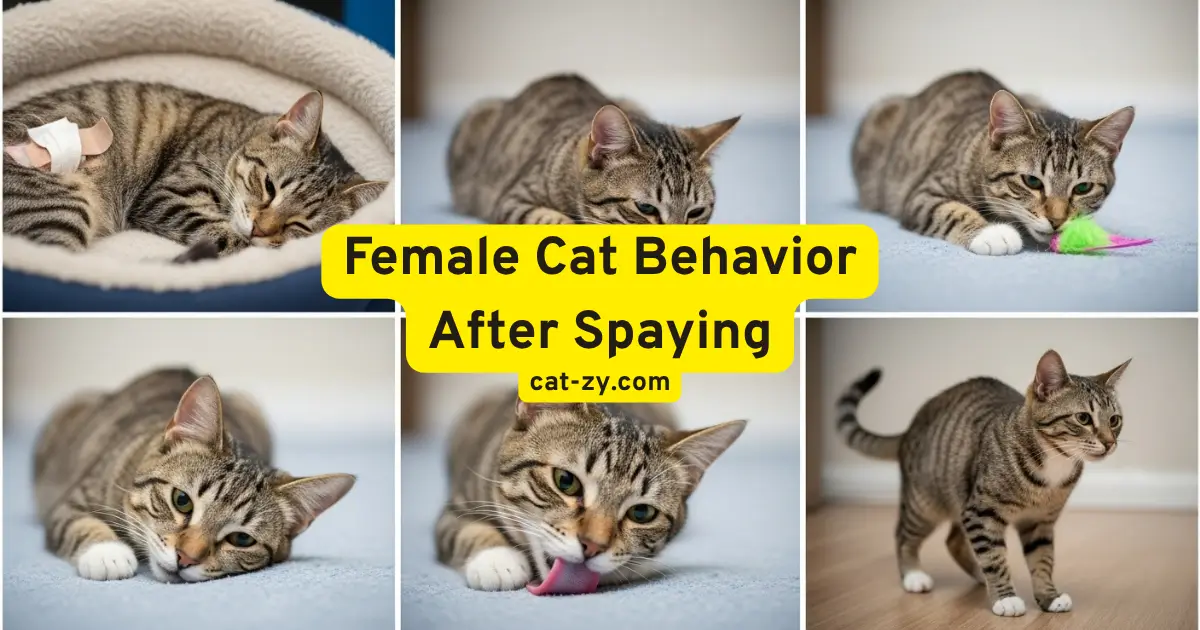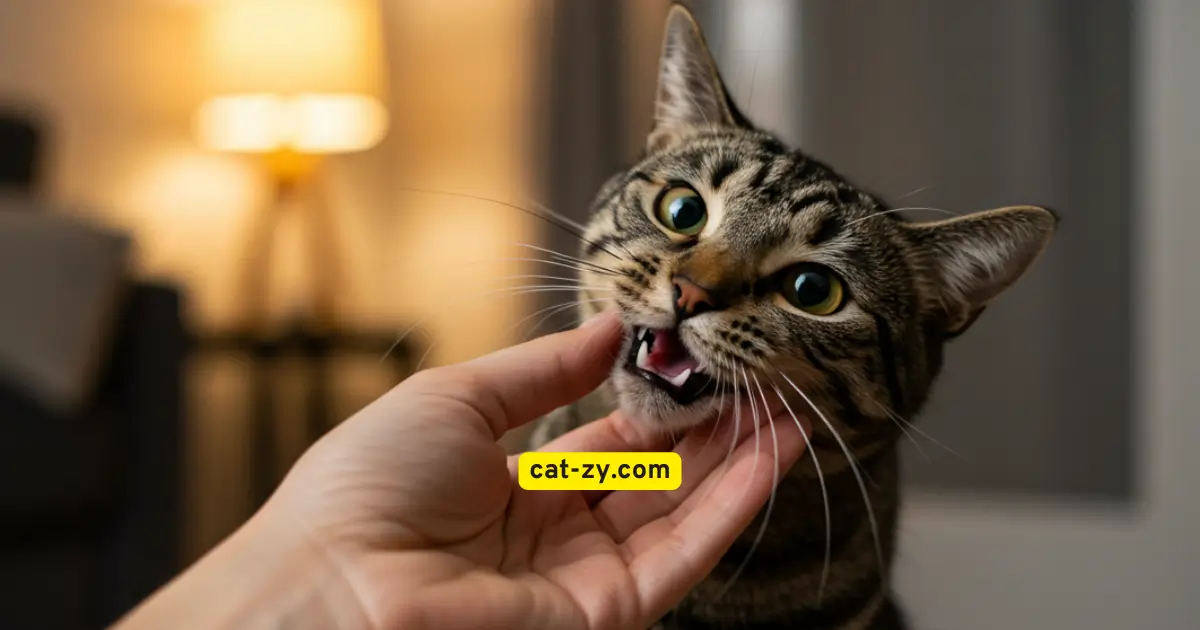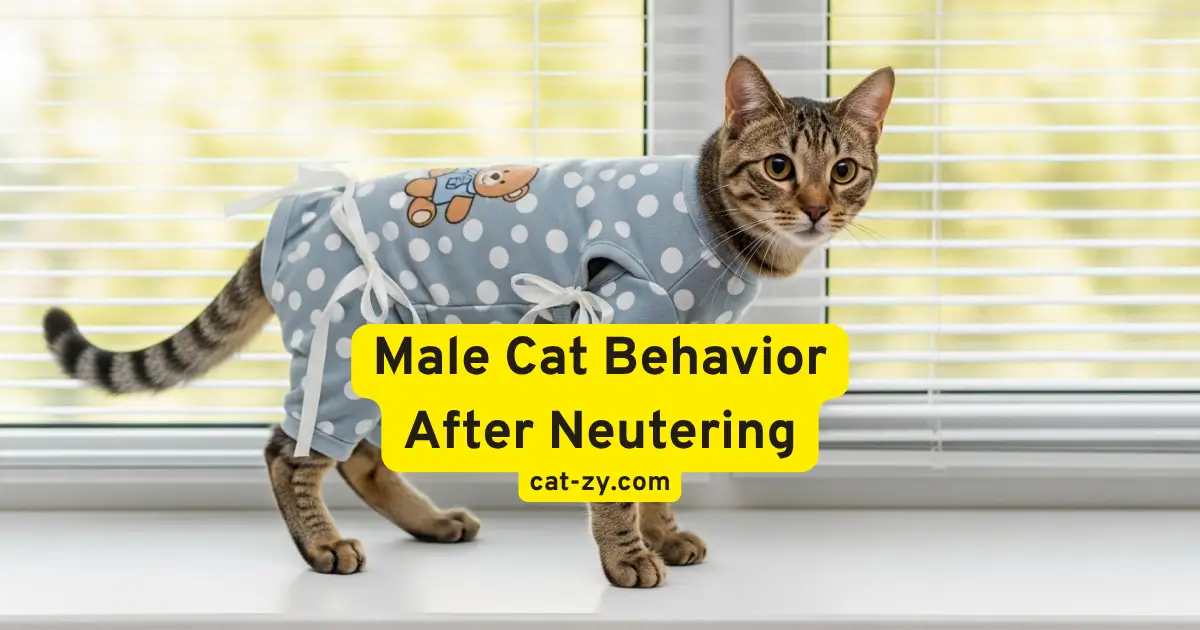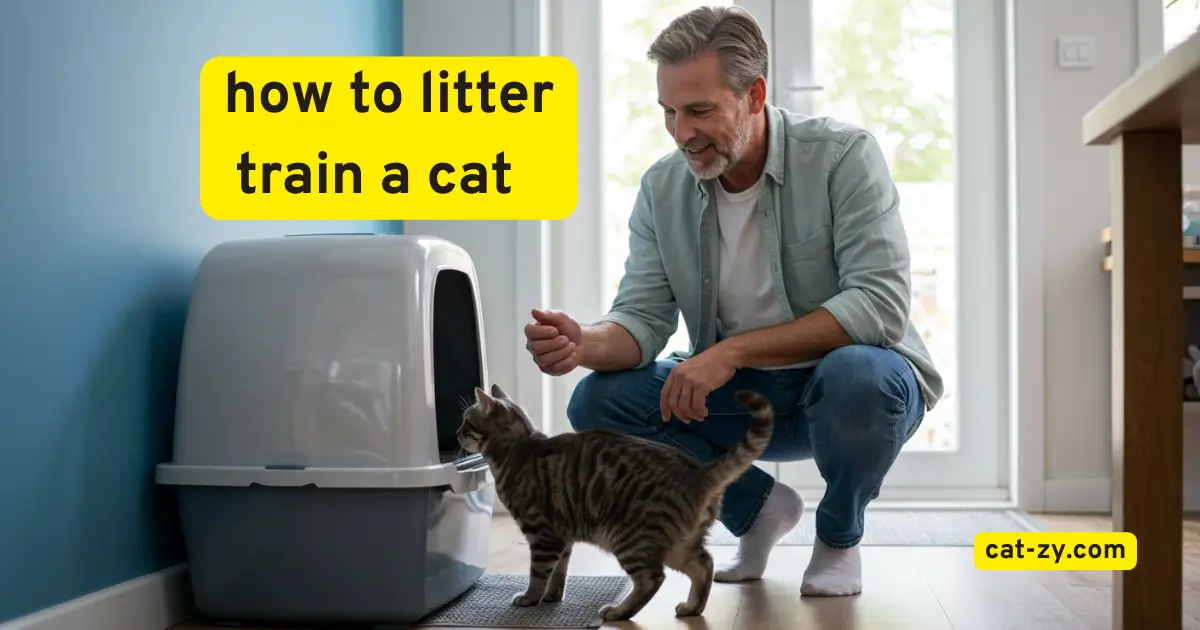Are Tulips Toxic to Cats? 7 Shocking Facts Revealed
If you’re a cat owner who loves brightening up your home with flowers, you might be wondering: Are tulips toxic to cats? The answer might surprise you. These popular spring blooms can be harmful to your pets.
Tulips are a beautiful addition to any garden or bouquet. But they can be dangerous for cats. It’s important for pet owners to know the risks.
In this article, we’ll look at the shocking facts about tulip toxicity. We’ll also talk about how to protect your pets. You’ll learn about the symptoms of tulip poisoning and how to prevent it. This will help keep your cats safe.
Table of Contents
The Hidden Dangers of Tulips for Your Feline Friend
The tulip, often seen as beautiful and innocent, can be dangerous for cat owners. It contains toxic substances that can harm cats. If you have tulips in your garden or home, it’s important to know the risks they pose to your cat’s health.
Why Cat Owners Should Be Concerned
Cat owners asking ‘Are tulips toxic to cats?’ should worry about the answer. These flowers have compounds that can upset a cat’s stomach or even be life-threatening. The toxic parts of tulips, called tulipalins, are found in all parts of the plant, but most in the bulbs. If your cat eats any part of a tulip, it could face serious health problems.
Common Misconceptions About Plant Toxicity
Many think only certain parts of a plant are toxic. But plants like tulips have toxic compounds in all their parts. Another myth is that cats will avoid toxic plants. But curious cats might not know the difference between safe and toxic plants, which is why understanding ‘are tulips toxic to cats‘ is so critical.
Are Tulips Toxic to Cats? The Definitive Answer
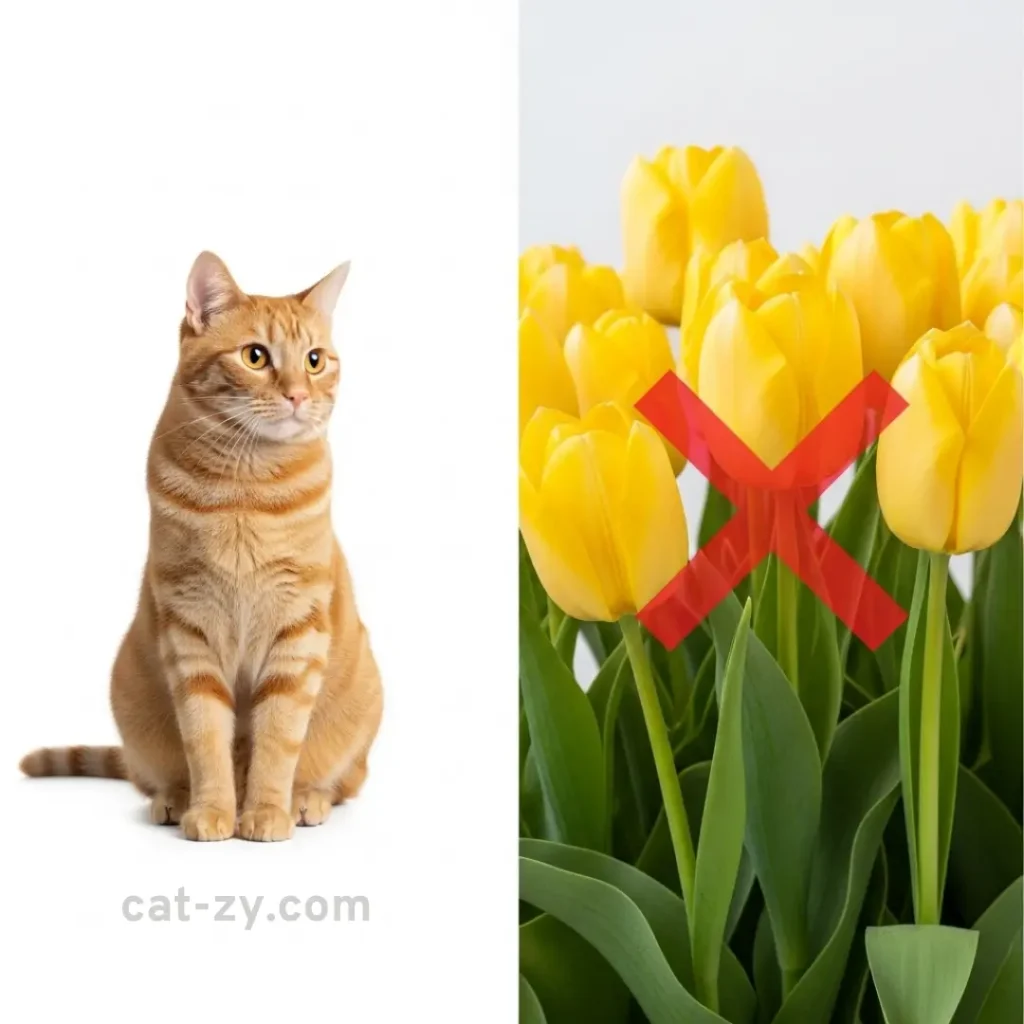
The tulip, a flower often linked with love and passion, can be harmful to cats. They are popular in gardens and arrangements but contain toxic compounds. These can be dangerous if cats eat them.
Scientific Evidence of Tulip Toxicity
Research shows tulips have allergenic lactones and tulipalin, which are toxic to cats. Studies have found cases of tulip poisoning in cats, showing the dangers.
Research Studies on Feline Tulip Poisoning
Studies have looked into tulip ingestion in cats, revealing symptoms and severity. They highlight the need to keep tulips away from pets.
Veterinary Consensus on Tulip Dangers
Vets agree tulips are a risk for cats. Pet owners should know the dangers. If a cat eats a tulip, get vet help quickly.
Toxicity Levels in Different Parts of the Tulip
The toxicity of tulips changes by part, with some being more dangerous. Knowing these differences helps reduce risks.
Ranking from Most to Least Toxic Parts
The bulb is the most toxic, followed by the leaves and then the flowers. This ranking helps cat owners understand the dangers.
Seasonal Variations in Toxicity
The danger of tulips changes with the seasons. The bulbs are most toxic when new or in bloom. Knowing these risks helps prevent poisoning.
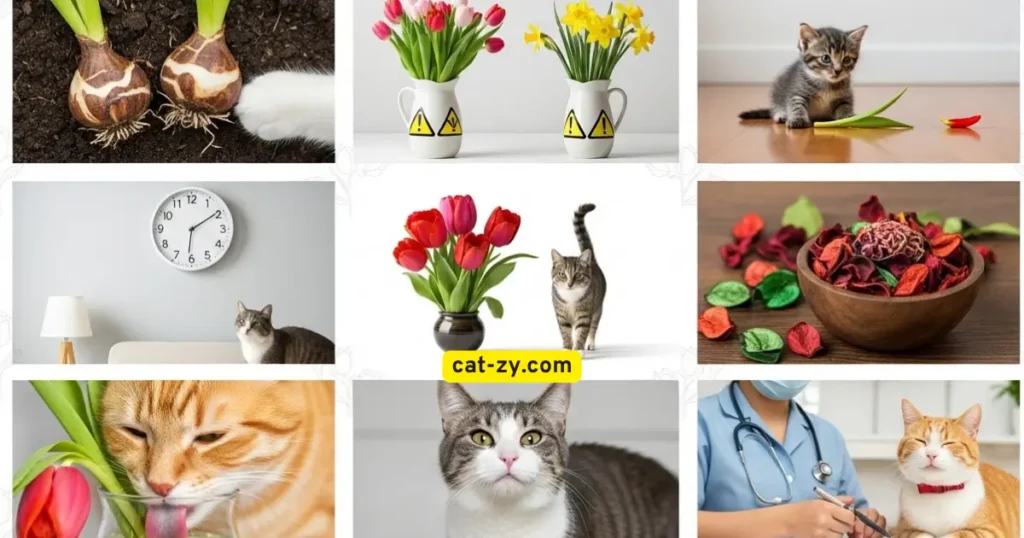
Shocking Fact #1: The Bulb Is the Most Dangerous Part
Tulip bulbs are very toxic to cats. They have the most tulipalin, a harmful compound. This can make cats very sick.
Why Tulip Bulbs Contain Higher Concentrations of Toxins
If you’re wondering ‘Are tulips toxic to cats? ‘, start with the bulbs—tulip bulbs store nutrients for the plant’s growth. They are full of tulipalin, a toxin that keeps animals and insects away.
The Biology Behind Bulb Toxicity
The bulb’s toxicity comes from its role in the plant. It stores nutrients and tulipalin to protect the plant.
How Cats Typically Access Bulbs
Cats might dig in the soil and find tulip bulbs. Since are tulips toxic to cats is answered with a definite yes, if you have tulips, keep your cat away from them.
Seasonal Risks: When Cats Are Most Likely to Encounter Bulbs
The danger of tulip bulbs changes with the seasons. Sometimes it is riskier for your cat.
Planting Season Dangers
In fall or early spring, bulbs are more visible. This makes it easier for cats to find them, which is especially concerning when you consider ‘Are tulips toxic to cats?‘
Indoor Forcing Bulb Risks
Indoor tulips can also be dangerous. Make sure they are out of your cat’s reach.
Shocking Fact #2: Tulips Contain the Same Toxins as Daffodils
Tulips and daffodils are both toxic to cats. They are popular spring flowers that add beauty but also risk to our pets.
Understanding Tulipalin A and B
The question ‘Are tulips toxic to cats‘ comes down to compounds called tulipalin A and B that tulips contain. These are also found in daffodils. They cause allergic reactions in cats.
How These Toxins Affect Feline Biology
The toxins tulipalin A and B can cause symptoms in cats. These range from mild irritation to severe reactions. The severity depends on the amount eaten and the cat’s sensitivity.
Concentration Levels in Different Tulip Varieties
The amount of tulipalin varies in different tulip types. But all tulips should be treated as potentially toxic to cats. The bulbs have the highest toxin levels.
Comparing Tulip Toxicity to Other Common Flowers
It’s good to compare tulip toxicity to other flowers. This helps understand the danger they pose to cats.
Relative Danger Scale of Common Household Plants
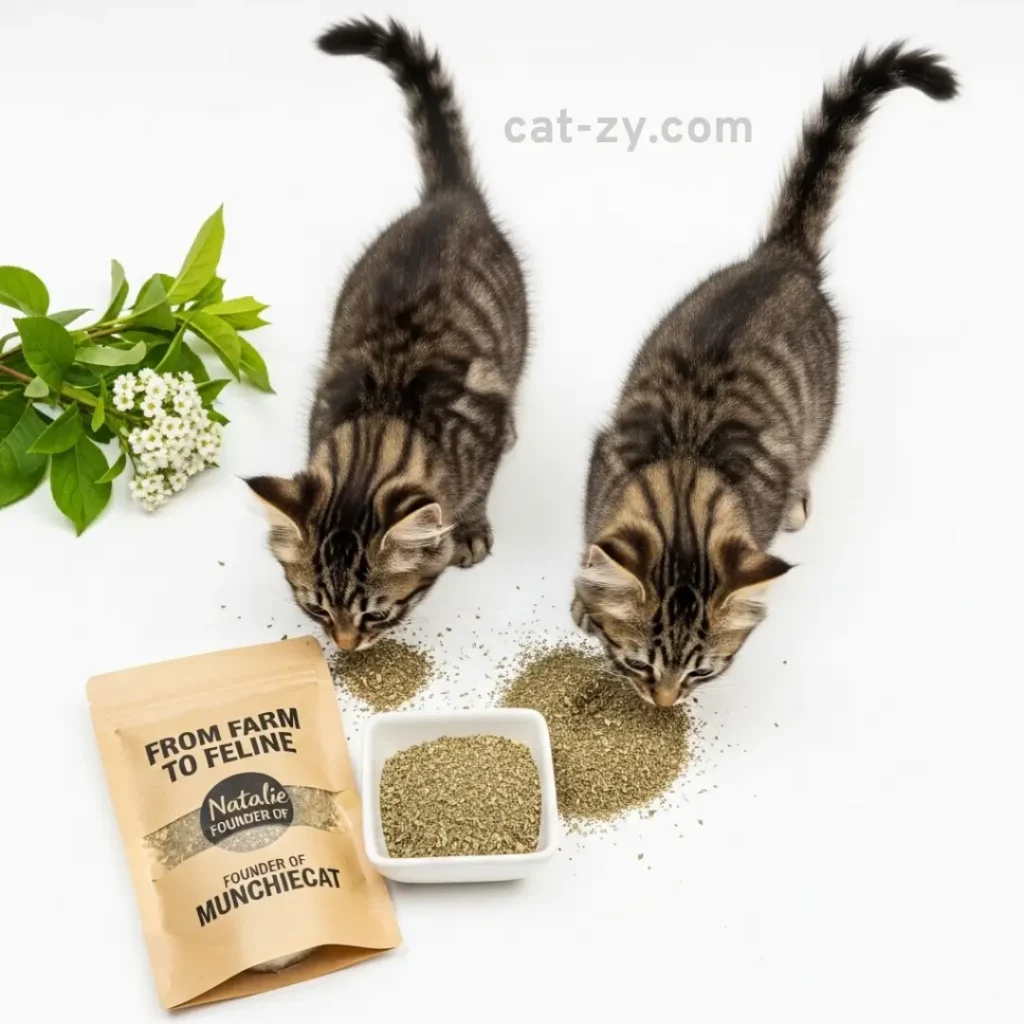
When comparing ‘Are tulips toxic to cats?‘ versus other plants, tulips are moderately to highly toxic. Lilies are even more dangerous. But catnip is generally safe.
Cross-Reactivity Concerns with Other Plants
Cats sensitized to one plant may react more to another. Knowing this helps cat owners choose safer plants for their homes.
Shocking Fact #3: Even Small Amounts Can Cause Severe Symptoms
Tulips can be very harmful to cats, even a little bit. Knowing the risks is key to keeping your pets safe.
Minimum Toxic Dose for Cats
Understanding ‘Are tulips toxic to cats?‘ also means figuring out the least amount of tulip that can harm a cat, which is tricky. It depends on the cat’s size, weight, and how it reacts to toxins.
Size and Weight Considerations
The size and weight of your cat matter a lot. When evaluating ‘Are tulips toxic to cats‘, smaller cats are more at risk because they weigh less. A small amount of tulip can be dangerous for cats under 10 pounds.
Individual Sensitivity Variations
Cats, like people, can react differently to toxins. Some cats might get very sick from tulips because of their own special traits. Watch your cat closely if you think they’ve eaten a tulip.
Why Cats Are More Sensitive Than Other Pets
The answer to ‘Are tulips toxic to cats‘ is especially serious because cats are extra sensitive to tulip toxins due to their body chemistry. Unlike dogs or other pets, cats have special ways their bodies handle toxins.
Unique Feline Metabolism Factors
Cats have a special way of breaking down toxins. This unique metabolism makes them more likely to get sick from tulip toxins.
Comparison to Dogs and Other Household Pets
While ‘Are tulips toxic to cats‘ is a definite yes, dogs can also get sick from tulips, but cats are more sensitive. This shows why cat owners need to watch out for tulip exposure more closely.
Shocking Fact #4: Symptoms Can Appear Within Minutes
When cats eat tulips, symptoms can show up fast. Tulip poisoning causes many signs that worry cat owners.
Early Warning Signs of Tulip Poisoning
The first signs of tulip poisoning in cats vary. They can affect the digestive system and change behavior or the nervous system.
Digestive System Symptoms
Cats may vomit, have diarrhea, or drool after eating tulips. These signs help the body get rid of the toxins.
Behavioral and Neurological Changes
Cats may also act tired, sad, or even have seizures. These signs show the toxins are affecting their nervous system.
The Progression of Symptoms If Left Untreated
If tulip poisoning isn’t treated quickly, symptoms can get worse. This can lead to serious health issues.
Timeline of Symptom Development
Symptoms can get worse in a few hours. If not treated, mild symptoms can turn serious.
Potential Long-term Complications
In bad cases, tulip poisoning can harm the kidneys or heart. Quick vet care is key to avoiding these problems.
Shocking Fact #5: Dried Tulips Remain Toxic
Did you know dried tulips, used in decorations, are toxic? This is important for cat owners. They might think dried tulips are safe.
The Persistence of Toxins in Dried Arrangements
Many cat owners asking ‘Are tulips toxic to cats?‘ don’t realize dried tulip arrangements can be a hidden danger. The toxins in tulips, like tulipalin, stay active even after drying.
How Long Toxins Remain Active
Toxins in dried tulips can last a long time. They can harm your cat if eaten. How long it depends on storage conditions.
Identifying Dried Tulips in Mixed Arrangements
It’s hard to spot dried tulips in mixed flower arrangements. Be careful with any dried flowers. They might have tulips.
Hidden Dangers in Potpourri and Decorations
Dried tulips are in potpourri and decorations. These items can be dangerous to your cat if they have tulips.
Common Household Items Containing Dried Tulips
Things like potpourri, wreaths, and dried flower arrangements might have tulips. If you’re concerned about ‘are tulips toxic to cats‘, know what’s in your home decor.
Safe Storage Practices for Dried Flowers
Keep dried flowers and arrangements away from your cat. Use sealed containers or high shelves to prevent accidents.
Shocking Fact #6: Tulip Water Can Be Just as Dangerous
Tulip water is not just harmless water from fresh flowers. It can be dangerous for your cat. When tulips sit in a vase, their toxins can mix into the water. This makes the water toxic to cats.
How Toxins Leach Into Vase Water
The question ‘are tulips toxic to cats’ extends to the vase water, where toxins come from the tulips’ natural defense. As tulips sit in water, they release toxins like tulipalin. These toxins can harm cats if they drink the water.
The Science of Toxin Transfer
Tulips release chemicals to protect themselves from harm. These chemicals can be toxic to cats if they drink them. This is because tulips have evolved to fight off pathogens and pests.
Duration of Water Contamination
Understanding ‘Are tulips toxic to cats‘ means knowing the water stays contaminated as long as the tulips are fresh. Even when the tulips start to wilt, the water can be harmful. This is because tulipalin stays in the water for a while.
Preventing Access to Flower Arrangements
To keep your cat safe, stop them from getting to tulip flower arrangements. You can do this by placing them carefully and using cat-proof vases.
Cat-Proof Vase Options
Cat-proof vases are made to be hard for cats to knock over. They have weighted bases or are made of materials cats can’t tip.
Strategic Placement of Flower Arrangements
Put flower arrangements where your cat can’t reach them. High shelves or rooms your cat doesn’t go to are good places. This helps prevent your cat from drinking the tulip water.
Shocking Fact #7: Most Cats Recover Fully With Prompt Treatment
If your cat eats tulips, there’s hope. With quick vet care, most cats get better. Knowing how to treat and care for your cat can make things easier.
Treatment Options for Tulip Poisoning
For tulip poisoning in cats, vets use a few methods. They aim to stop the toxins from being absorbed and manage symptoms.
Veterinary Interventions and Procedures
Vets might make your cat vomit, give activated charcoal, and use IV fluids. They also watch for heart and lung problems.
At-Home Supportive Care During Recovery
At-home care means giving your cat a quiet place to rest. Make sure they drink water and follow any vet meds.
Recovery Timeline and Prognosis
The time it takes for a cat to get better varies. It depends on how bad the poisoning is and how fast they get help. Usually, cats start to feel better in a few days.
Expected Recovery Milestones
Your cat should start to get better in 24 to 48 hours. They should fully recover in about a week.
Factors That Influence Recovery Success
Prompt treatment is key to a cat’s recovery. How many tulips they ate and their health also matter a lot.
Emergency Response: What to Do If Your Cat Eats Tulips
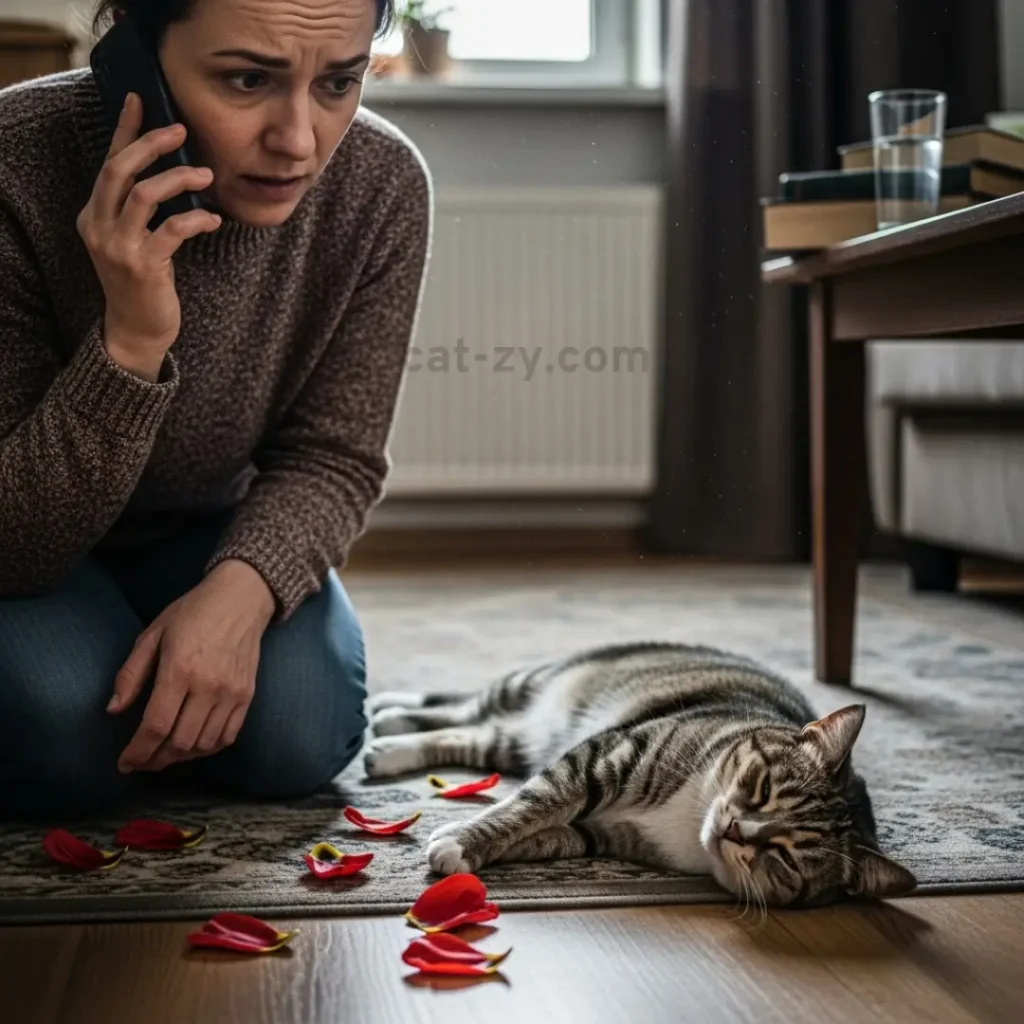
If your cat eats tulips, act fast. Tulips have toxic parts that can harm cats. Symptoms range from vomiting to serious issues like breathing problems.
Immediate First Aid Steps
See your cat eating tulips? Stay calm and act quickly. First, remove any tulip parts from your cat’s mouth and area.
Do’s and Don’ts Before Reaching a Vet
Don’t try to make your cat vomit unless a vet tells you to. Do keep tulip parts away from your cat. Also, do note how much and what parts of the tulip they ate.
Information to Gather for the Veterinarian
Getting the right info helps your vet help your cat. Write down the tulip type, how much was eaten, and when. This info helps figure out how bad the poisoning is.
When to Rush to the Veterinarian
If your cat shows signs of tulip poisoning, like drooling or vomiting, go to the vet fast. Quick action can make a big difference.
Critical Warning Signs Requiring Immediate Care
Look out for serious signs like trouble breathing or seizures. These mean your cat needs emergency vet care right away.
What to Expect During Emergency Treatment
When you get to the vet, they’ll check your cat’s condition. They might give treatments like activated charcoal. They’ll also watch your cat’s vital signs and treat symptoms.
Cat-Safe Alternatives to Tulips for Your Home and Garden
If you own a cat, you don’t have to miss out on beautiful flowers. There are many cat-safe alternatives to tulips. These options are vibrant and safe for your feline friends.
Beautiful Non-Toxic Flowers for Cat Owners
Choosing the right flowers is key to a safe and lovely space for you and your cat. Here are some beautiful, non-toxic options:
Indoor Cat-Safe Flowering Plants
For indoor spaces, think about African Violets, Parlor Palms, or Prayer Plants. These plants are safe for cats and add elegance to your decor.
Outdoor Garden Options That Won’t Harm Cats
Outdoors, plant Catmint, Sunflowers, or Zinnias. These flowers are safe for cats and brighten your garden. They’re also easy to care for.
Creating a Cat-Friendly Garden Space
Creating a cat-friendly garden is more than just picking safe plants. Here are some tips for a harmonious outdoor space:
Designated Cat Garden Areas
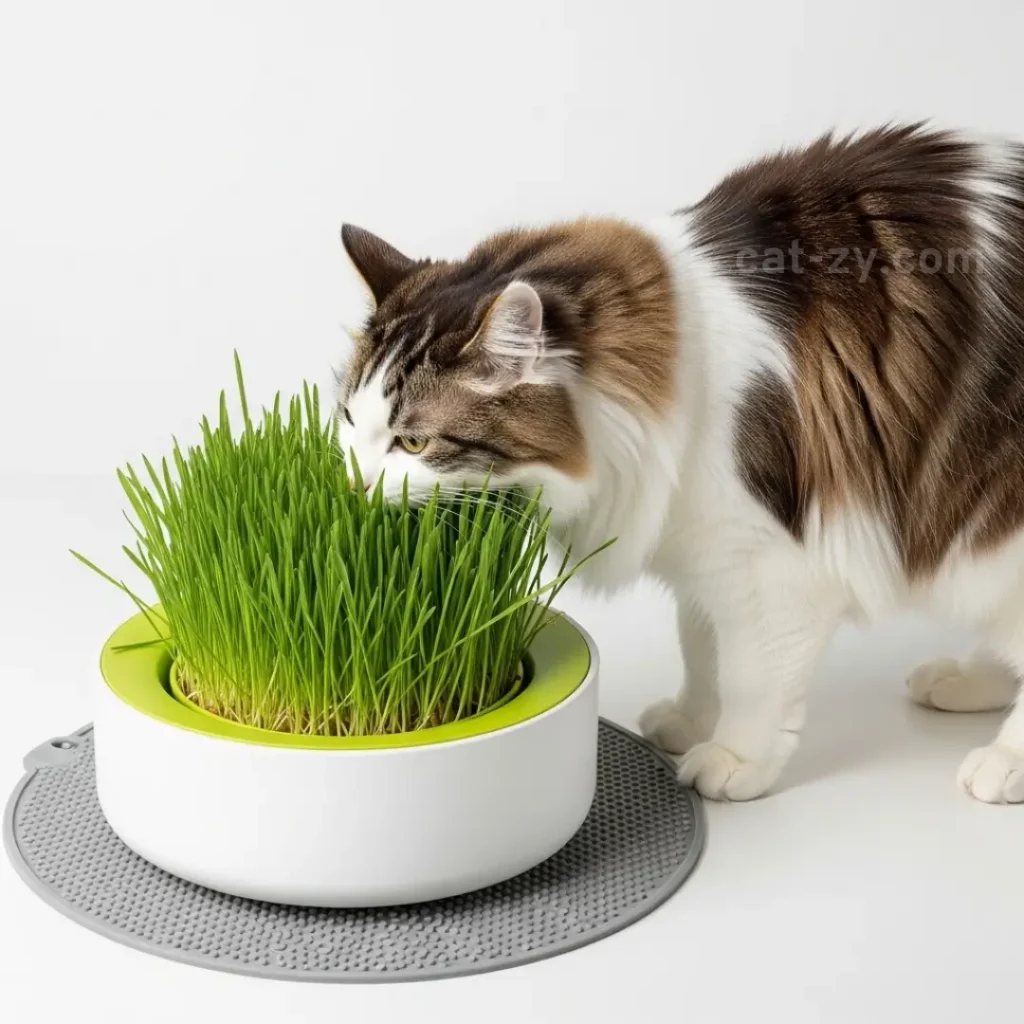
Think about setting aside a part of your garden for cat-friendly plants. It’s a fun way to let your cat enjoy the outdoors safely. Include plants like Cat Grass or Catnip to attract your cat.
Deterrent Strategies for Protecting Toxic Plants
If you want to keep some tulips or other toxic plants, use deterrents. Try citrus peels or vinegar sprays around the plants. They’ll keep your cats away.
Conclusion: Balancing Beauty and Safety for Cat Owners
As a cat owner, you want a beautiful and welcoming home. But tulips can be dangerous for cats. Even a little bit can make them very sick.
Now that you know ‘are tulips toxic to cats’, remember that tulip bulbs are more toxic, and dried tulips are too. Even tulip water can harm your cat. Knowing these dangers helps keep your cat safe.
To keep your cat safe, find cat-safe alternatives or block their access to tulips. If your cat eats tulips, get vet help fast. This way, you can have a beautiful home that’s safe for both you and your cat.
So, are tulips toxic to cats? Yes, they can be. But with the right steps, you can keep your cat safe. Enjoying tulips and keeping your cat healthy is possible with the right precautions.
FAQ
Are tulips toxic to cats?
Yes, tulips are toxic to cats. They can cause symptoms ranging from mild to severe if eaten.
What parts of the tulip are most toxic to cats?
The bulb is the most toxic part. But the flowers, leaves, and stems also contain toxins that can harm cats.
Can cats be allergic to tulips?
Some cats may be more sensitive to tulip toxins. But it’s not an allergy. It’s a toxic reaction, not an allergic one.
How much tulip material does a cat need to ingest to be poisoned?
Even small amounts can cause symptoms. The exact amount depends on the cat’s size, weight, and sensitivity.

